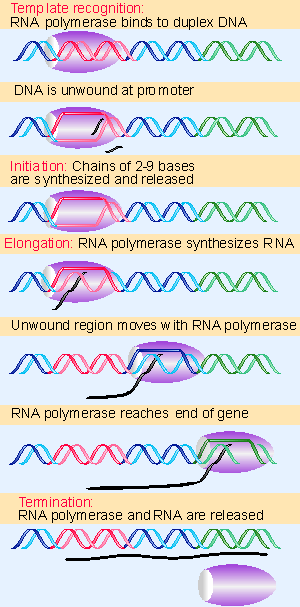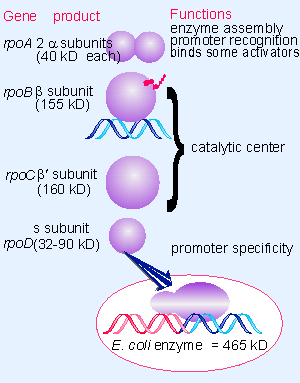3. RNA polymerase consists of multiple subunits
9.3 RNA polymerase consists of multiple subunits |
| Key terms defined in this section |
| Promoter is a region of DNA involved in binding of RNA polymerase to initiate transcription. Terminator is a sequence of DNA, represented at the end of the transcript, that causes RNA polymerase to terminate transcription. |
 |
Figure 9.7 Transcription has four stages, which involve different types of interaction between RNA polymerase and DNA. The enzyme binds to the promoter and melts DNA, remains stationary during initiation, moves along the template durign elongation, and dissociates at termination. |
The transcription reaction can be divided into the stages illustrated in Figure 9.7, in which a bubble is created, RNA synthesis begins, the bubble moves along the DNA, and finally is terminated:
- Template recognition begins with the binding of RNA polymerase to the double-stranded DNA at a promoter. Then the strands of DNA are separated to make the template strand available for base pairing with ribonucleotides. The transcription bubble is created by a local unwinding that begins at the site bound by RNA polymerase.
- Initiation describes the synthesis of the first nucleotide bonds in RNA. The enzyme remains at the promoter while it synthesizes the first ~9 nucleotide bonds. The initiation phase is protracted by the occurrence of abortive events, in which the enzyme makes short transcripts (<9 bases), releases them, and then starts synthesis of RNA again. The initiation phase ends when the enzyme succeeds in extending the chain and escapes from the promoter. The sequence of DNA needed for RNA polymerase to bind to the template and accomplish the initiation reaction defines the promoter. Abortive initiation probably involves synthesizing an RNA chain that fills the active site. If the RNA is released, the initiation is aborted and miust start again. Initiation is accomplished if and when the enzyme manages to move along the template to refill the active site with the next region of the DNA.
- During elongation the enzyme moves along the DNA and extends the growing RNA chain. As the enzyme moves, it unwinds the DNA helix to expose a new segment of the template in single-stranded condition. Nucleotides are covalently added to the 3′ end of the growing RNA chain, forming an RNA-DNA hybrid in the unwound region. Behind the unwound region, the DNA template strand pairs with its original partner to reform the double helix. The RNA emerges as a free single strand. Elongation involves the movement of the transcription bubble by a disruption of DNA structure, in which the template strand of the transiently unwound region is paired with the nascent RNA at the growing point.
- Termination involves recognition of the point at which no further bases should be added to the chain. To terminate transcription, the formation of phosphodiester bonds must cease, and the transcription complex must come apart. When the last base is added to the RNA chain, the transcription bubble collapses as the RNA-DNA hybrid is disrupted, the DNA reforms in duplex state, and the enzyme and RNA are both released. The sequence of DNA required for these reactions is called the terminator.
Originally defined simply by its ability to incorporate nucleotides into RNA under the direction of a DNA template, the enzyme RNA polymerase now is seen as part of a more complex apparatus involved in transcription. The ability to catalyze RNA synthesis defines the minimum component that can be described as RNA polymerase. It supervises the base pairing of the substrate ribonucleotides with DNA and catalyzes the formation of phosphodiester bonds between them.
But ancillary activities are needed to initiate and to terminate the synthesis of RNA, when the enzyme must associate with, or dissociate from, a specific site on DNA. The analogy with the division of labors between the ribosome and the protein synthesis factors is obvious.
All of the subunits of the basic polymerase that participate in elongation are necessary for initiation and termination. But transcription units differ in their dependence on additional polypeptides at the initiation and termination stages. Some of these additional polypeptides are needed at all genes, but others may be needed specifically for initiation or termination at particular genes.
The best characterized RNA polymerases are those of eubacteria, for which E. coli is a typical case. A single type of RNA polymerase appears to be responsible for almost all synthesis of mRNA, and all rRNA and tRNA, in a eubacterium. About 7000 RNA polymerase molecules are present in an E. coli cell. Many of them are engaged in transcription; probably 2000 V5000 enzymes are synthesizing RNA at any one time, the number depending on the growth conditions.
 |
Figure 9.8 Eubacterial RNA polymerases have four types of subunit; a, b, and b have rather constant sizes in different bacterial species, but s varies more widely. |
The complete enzyme or holoenzyme in E. coli has a molecular weight of ~465 kD. Its subunit composition is summarized in Figure 9.8.
The β and β′ subunits together make up the catalytic center; their sequences are related to those of the largest subunits of eukaryotic RNA polymerases (see 20 Initiation of transcription), suggesting that there are common features to the actions of all RNA polymerases. The β subunit can be crosslinked to the template DNA, the product RNA, and the substrate ribonucleotides; mutations in rpoB affect all stages of transcription. Mutations in rpoC show that β′ also is involved at all stages.
The α subunit is required for assembly of the core enzyme. When phage T4 infects E. coli, the α subunit is modified by ADP-ribosylation of an arginine. The modification is associated with a reduced affinity for the promoters formerly recognized by the holoenzyme, suggesting that the α subunit plays a role in promoter recognition. The α subunit also plays a role in the interaction of RNA polymerase with some regulatory factors.
The σ subunit is concerned specifically with promoter recognition, and we have more information about its functions than on any other subunit (see below).
The existence of much smaller RNA polymerases, comprising single polypeptide chains coded by certain phages, demonstrates that the apparatus required for RNA synthesis can be much smaller than that of the host enzyme. These enzymes give some idea of the "minimum" apparatus necessary for transcription. They recognize just a few promoters on the phage DNA; and they have no ability to change the set of promoters to which they respond. So they are limited to the intrinsic ability to recognize certain specific DNA-binding sequences and to synthesize RNA.
The RNA polymerases coded by the related phages T3 and T7 are single polypeptide chains of <100 kD each. They synthesize RNA at rates of ~200 nucleotides/second at 37 XC, more rapidly than bacterial RNA polymerase. The initiation reaction shows very little variation.
By contrast, the enzyme of the host bacterium can transcribe any one of many (>1000) transcription units. The host enzyme therefore requires the ability to interact with a variety of host and phage functions that modify its intrinsic transcriptional activities. The complexity of the enzyme therefore at least in part reflects its need to interact with a multiplicity of other factors, rather than any demand inherent in its catalytic activity (for review see 76).
This section updated 1-10-2000
| Reviews | |
| 76: | Helmann, J. D. and Chamberlin, M. (1988). Structure and function of bacterial sigma factors. Ann. Rev. Biochem 57, 839-872. |